Snow this morning. Because winter is funny like that.
/

On a side note: I love Camera Awesome! for my iPhone. Best photo app around I've found so far.
What do you mean you don't have an iPhone? Unfollow!

On a side note: I love Camera Awesome! for my iPhone. Best photo app around I've found so far.
What do you mean you don't have an iPhone? Unfollow!
By now, our fall trips to the slaughterhouse are a thing of family tradition. Not only do we end up with a couple of upright freezers packed into a sort of three-dimensional meat jigsaw-puzzle-fullness each Fall, we also get the opportunity to try our hand at preserving and curing in various forms.
In the past couple of years, I've made chorizo, pancetta, and even prosciutto (which, turns out, is dead simple - salt, a whole leg of pig, and about 18 months hanging in a temperature controlled, even-humidity place, and boom: You have the equivalent of several hundred dollars worth of Boar's Head sliced prosciutto. This will also be your excuse to finally buy that meat slicer you've been eyeing, to get those lovely even, thin slices).
The one area I had not yet ventured into, however, was salami. I had been shy about mixing my ground porky bits and stuffing them into intestines to hang - it seemed somehow much more likely to end up in extreme food poisoning than anything else I had yet tried, and I wanted to get a little more curing success under my belt, so to speak, to be confident about it all before I made an attempt at something so mysterious.
This past November, we brought home two of the most beautiful pigs we'd ever had (slaugtered and butchered, of course. Otherwise, they would have made a real mess in the car). The fat-to-meat ratio was gorgeous - these pigs (both Hampshire sows raised at our local dairy farm since early Spring) had clearly led a happy life. Well. Imean, right up until that last bit with going to the slaughterhouse and all. But, you know. They're going to a good cause.
I had told my butcher that I'd be trying my hand at salami this year, and to go ahead and put the trimmings aside in a manageable cut for me to grind myself
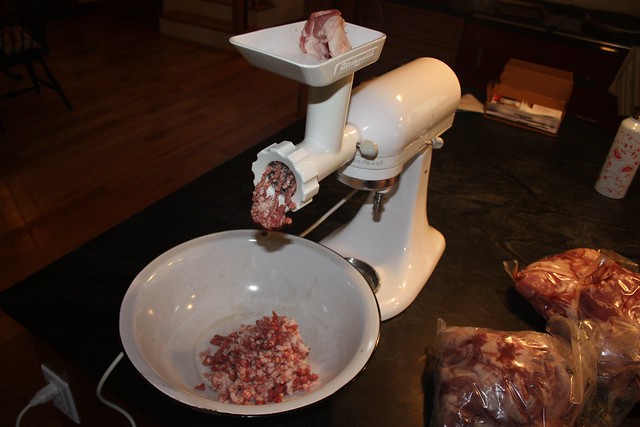
Looks amazing already, doesn't it?
The Boy was right there with me - we followed a very basic and straightforward recipe: Some salt. Some peppercorns. A bit of nice white wine. Some more salt. And a whole lot of pig.
You could add fennel or garlic or other seasonings at this point, but it seemed kind of overkill when we had such a great product to start with. I let the Boy work it all in together, and we left it to refrigerate for a day or so, to blend nicely.
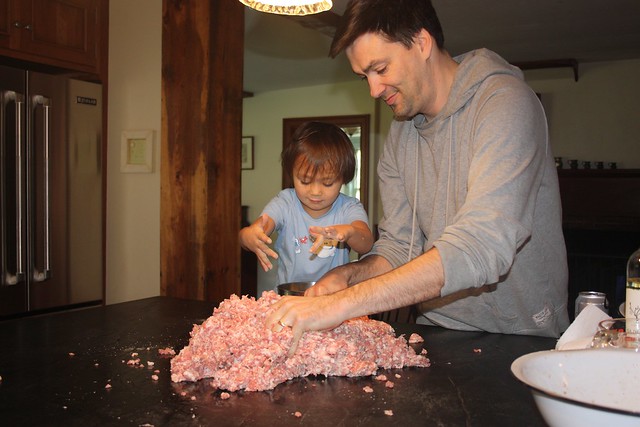
There were then many, many long conversations about the casings. Mike, my most respected master butcher, recommended I use collagen casings. They're natural material, but much easier & more forgiving to work with than the more traditional intestines. I chuckled, and shook my head. I'm not doing this the easy way. I'm doing this the traditional way. Point of pride!
For the record: I am stupid.
The traditional way.
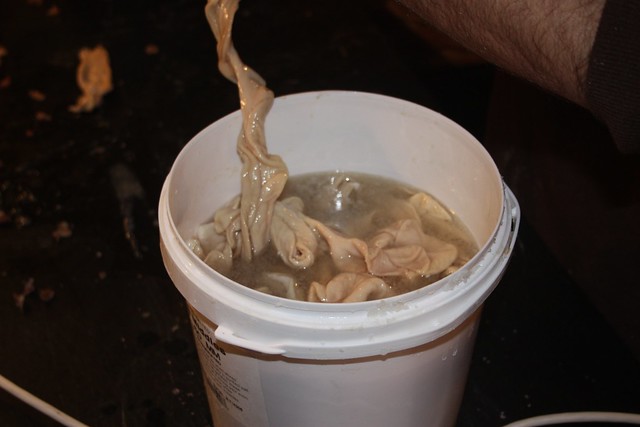
Don't get me wrong. I had done my research. I found my intestines on the internet, just like the (Italian) settlers did. First, I ordered lambs intestines. They came in a bucket. (not the bucket above). Problem is: lambs are small. I quickly discovered that their intestines were big enough to make a sausage the size of maybe a rather puny pepperoni stick, or perhaps a moderately healthy Slim Jim, and that was about it. So I chucked my ground pork back into the fridge and overnight-ordered some much larger hog middles.
That's right: 'Hog Middles'
These are the smaller end of the hog's large intestines. (The large ends are called "bungs".)
(No bungs for us.)
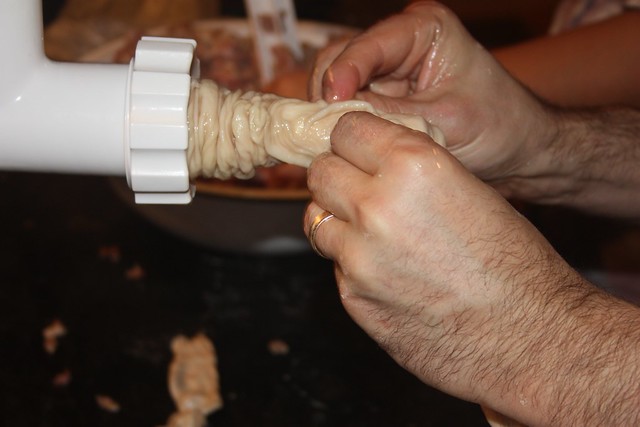
For those of you thinking about running over to Amazon.com and ordering up some hog middles right away (oh yes, you can get anything there), for the sake of your marriage, I would encourage you to read on a moment more.
On the outside of the bucket of Hog Middles, there was a friendly warning:
The contents of this bucket smell like shit. That's not because they've gone off. They're intestines. If the smell is simply too bad to handle, stick them in the fridge for a while and let them cool off. It won't make the smell go away, but it'll be manageable. Sort of.
What did you expect - Roses?
(Editors Note: I may have paraphrased the above just a bit. But trust me: Not by much)
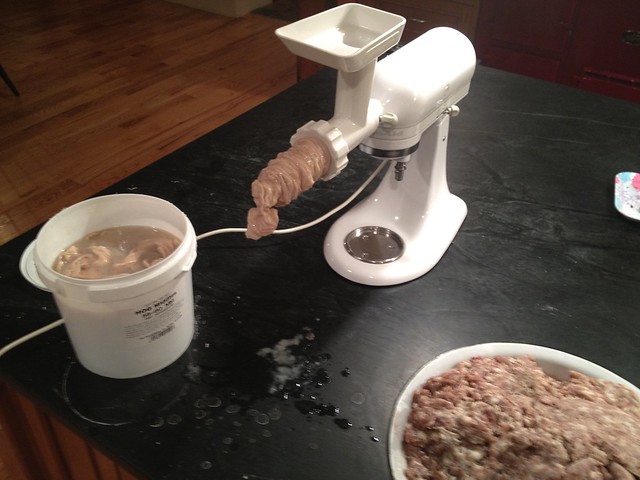
The manufacturer's label did not lie. This stuff truly stinks to high heaven, and the contents are coated in intestine-goop + salty brine. Note the drippy mess undernath the casings. Lovely.
This was about the time we lost the Boy's interest.
You know how they say that you never really want to see sausage being made? I'm here to tell you: making sausage is absolutely no big deal. Child's play. Like making hamburgers. No problem.
Stuffing sausage, on the other hand, is the stuff of psycho-ward nightmares.
First: it is a two person job. Do not try to do this on your own. You will fail. And the hog middles will mock your attempts to try and keep things together. Before they burst and throw up all over your shoes.
Even with two people, it is still a fairly serious bit of labor to keep things going, get the casings stuffed to the proper tension without bursting, and tie things off along the way.
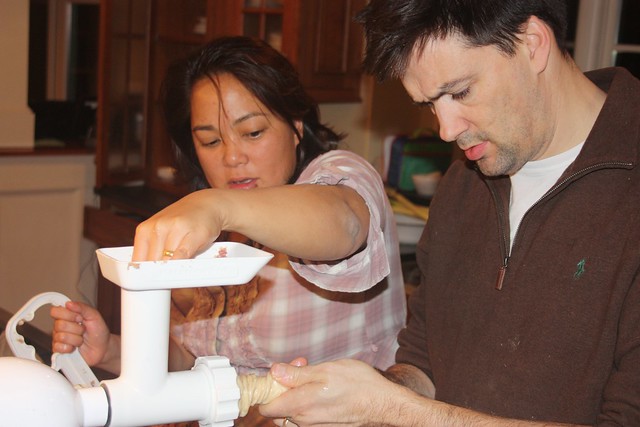
On the other hand, doing this in pairs - especially with your significant other - leads to all new levels of sniggering and innuendo. Which makes up for most of the mess.
I mean, come on. Who wouldn't turn into a 12 year old during a night of this?

Sure, after a couple of hours of work, you end up covered in hog-middle-goop and pig fat, and smelling worse than the back end of, well, the pig that you've been up to your elbows in all evening.
And yeah, you're cursing and half pissed from finishing off the rest of that bottle of wine, but eventually, you do end up with something to show for your efforts.
And it is the promise of pork perfection.
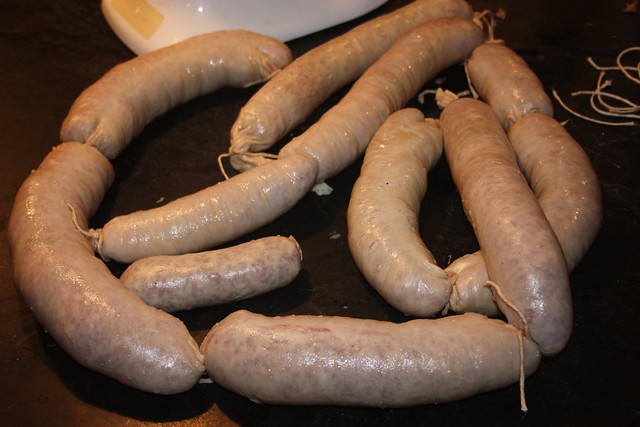
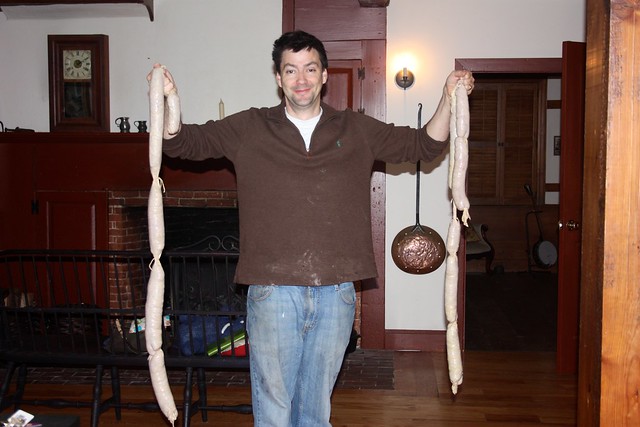
I look disgusting in this picture because I am disgusting - my clothes and skin and hair full of salty intestine goo, and I smelled of pork musk for at least another 48 hours. But behold: THE SALAMI!
The trick now is to hang it in a place that's cool and stable and out of the way. And then to walk away from it for several months.
We left ours hanging here for about 14 weeks.
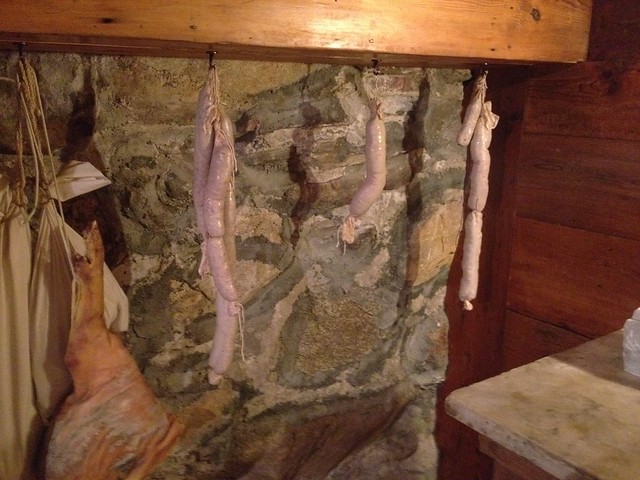
For the first time, I was truly impatient to try our product. With all our other curing attempts, I had been the one to push back and remind my family that time would only make it better (that prosciutto in the left hand corner of the picture above had been hanging for 22 months at that point).
But I kept sneaking back into the cellar to check on the salamis - smell them to make sure they were ok; touch them to feel them firming up. Finally, last week, I declared them "ready enough" and used the excuse of an invitation to our good friends, Dan & Meredith (who helped us make cheese previously) to snip one length off and take it over for a trial.
I knew they were brave enough and food-inclined enough to be willing to taste our inaugural salami with us. Besides, I figured I could give them the first slice, and see if they survived.
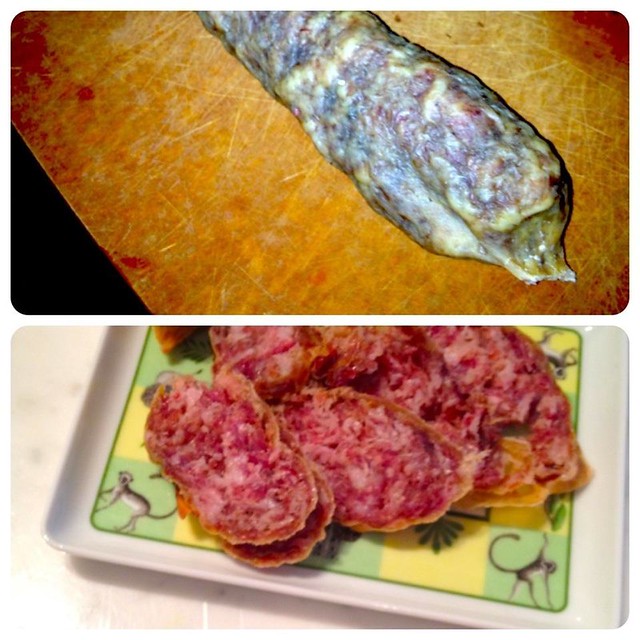
It turned out beautifully.
The flesh of the salami was a little less firmly packed than I might have liked - although this might also just be fixed by letting it cure an extra month or two. But with a slice of cheese or a little wedge of fig preserve, this was amazing.
I'm not certain if it was good enough to go through the ordeal of the natural casings again, but maybe if I get an extra volunteer or two to help, it may actually be worth doing again.
However, the next time I see the price of salami at the grocery store, I'll have a much better appreciation for why it's so damn expensive.
Over on my friend and neighbor's HenCam.com (which is a fantastic resource for all things chicken-keeping related, and voted one of the internet's best time-sinks by Country Living and BBC or some such), I shared some thoughts on what we're doing about our flock of chickens this year, and why.
Since it is a natural follow on to my last post, I thought I'd reproduce it here as well.
How many new chicks to get this year has been the topic of much conversation at our house lately – we’ve just put in our spring order (chicks arrive in April). The primary purposes of our flock are to 1) provide a living lesson in business and the care of animals for the children (they sell the eggs) and 2) to keep me amused.
Whether you're an old hand at chicken-keeping, or just thinking about getting a couple of birds for the first time - knowing why you're getting them should certainly be an important part of your breed selection.
With our goals in mind, I always am looking for: a) a steady supply of eggs, and b) a good variety of hens (both egg & feather color).
I’ve got a no [boys/feathered feet/feathered heads] rule, just because I’m a low maintenance (i.e. “lazy”) kind of chicken farmer. (Roosters make noise that annoy me/the neighbors. Feathered feet and the crazy feathered-headgear birds like Polish hens are high maintenance in care/trimming to keep healthy that I'm not willing to invest time in).
I’ve also generally shied away from bantam (think: miniature chickens) breeds because I feel bad about the kids selling smaller eggs.
To maintain a flock of around 25 reasonably productive hens, I’ve found that we need to order/replenish about 5-10 hens a year.
Predators generally account for about 2/3rds of our loss (hawks, raccoons, possums, fisher cats) (but mostly hawks), which is just part of the life and risk that comes with free-range chicken keeping. Plus: while we have been lucky/careful enough to avoid any other serious issues, we always lose a couple per year to other natural causes (egg bound, cancer, etc).
Then there was the rooster that showed up in last year’s order. He ended up on the dinner table (see the “no boys” rule above).
Chickens can live to be 15+ years old with a luck and a (more than) a bit of care, and our oldest hens are about 4 years old. But they start to slow down in laying after a while, and because of their vulnerabilty to anything with a beak, claw or teeth and their tendency to go from perfectly healthy to death's door with very few indicators, the numbers of backyard chickens that make it into the 5+ age range are definitely a minority. We've also always been pretty pragmatic about our hens: they're not pets; they're production livestock. So with the rare exception that displayed a bit more personality, we take very few extraordinary measures to extend the lives of our birds. (e.g. none of them have ever been crated for a trip to our veterinarian).
This year, the Critter and I settled on 10-ish as the magic number. I have bought small lots of pullets (young hens just about ready to start laying) from local(-ish) folks (my bride’s preference), but I was looking for a little more variety this order. And I kind of like getting them as chicks. The kids love that part of the process. However, this limits the places I can order or buy the hens to a very few sellers unless I find someone to share an order. I figured I’d go ahead and try MyPetChicken.com – I’ve heard mixed reviews, and the cost/chicken is relatively high, but they do offer vaccinated chicks and have a respectable selection, so I’m willing to give it a try.
I think we’ve had around 15 different breeds at this point. I don’t like to have just 1 of any bird generally, so that was a factor as well. We spent some time talking about which chickens had been our favorite and why, and which we were willing to try out and ended up with the following:
For the first time, I’ve also ordered a couple of Golden Sebright bantam hens. We’ll keep back the smaller eggs for our own consumption, and I thought it’d be fun to mix it up a bit.
This will take us up to 30 birds total, but I’m planning to re-design and build an expanded coop this summer. Plus, my experience is that you lose up to 10-15% of chicks in the first 6-9 months (they get sick/die after shipping issues, or they're bred weak, or other random chicken issues). Combine with expected attrition of the current flock, and this should keep our numbers relatively steady on average, and the birds happy.
By the way, introducing new birds to an existing flock is a bit of a trick. (We lost a couple of adolescent hens to bullying from the older girls before we got the hang of it). Terry's got a good reference with some ideas here. I'll post our method (which has consistently worked for the last 3 batches of new birds) later in the spring.
Geek. Amateur homesteader. Enthusiastic cook. Occasional doodler. Avid eater of food, Father. Bad banjo player. .
Recent Posts